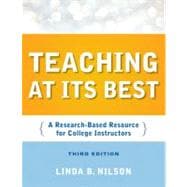This best-selling handbook is an essential toolbox—a compilation of hundreds of practical teaching techniques, formats, classroom activities, and exercises. It is now newly revised and expanded to cover more on the topics relevant to today's classroom such as technology and the Internet, simulations and games, diversity, service learning, and faculty evaluation systems.
This third edition of the best-selling handbook offers faculty at all levels an essential toolbox of hundreds of practical teaching techniques, formats, classroom activities, and exercises, all of which can be implemented immediately. This thoroughly revised edition includes the newest portrait of the Millennial student; current research from cognitive psychology; a focus on outcomes maps; the latest legal options on copyright issues; and how to best use new technology including wikis, blogs, podcasts, vodcasts, and clickers. Entirely new chapters include subjects such as matching teaching methods with learning outcomes, inquiry-guided learning, and using visuals to teach, and new sections address Felder and Silverman's Index of Learning Styles, SCALE-UP classrooms, multiple true-false test items, and much more.
Praise for the Third Edition of Teaching at Its Best :
Everyone—veterans as well as novices—will profit from reading Teaching at Its Best, for it provides both theory and practical suggestions for handling all of the problems one encounters in teaching classes varying in size, ability, and motivation."—Wilbert McKeachie, Department of Psychology, University of Michigan, and coauthor, McKeachie's Teaching Tips
This new edition of Dr. Nilson's book, with its completely updated material and several new topics, is an even more powerful collection of ideas and tools than the last. What a great resource, especially for beginning teachers but also for us veterans!"—L. Dee Fink, author, Creating Significant Learning Experiences
This third edition of Teaching at Its Best is successful at weaving the latest research on teaching and learning into what was already a thorough exploration of each topic. New information on how we learn, how students develop, and innovations in instructional strategies complement the solid foundation established in the first two editions."—Marilla D. Svinicki, Department of Psychology, The University of Texas, Austin, and coauthor, McKeachie's Teaching Tips








